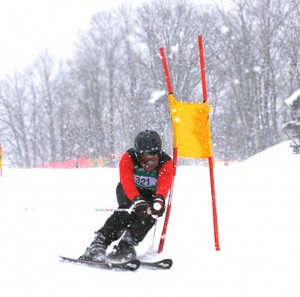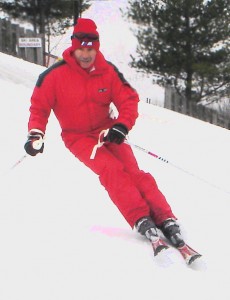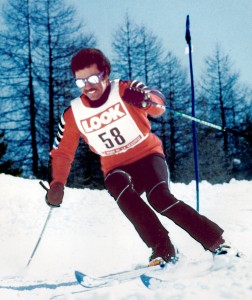
I was born in Paris France. I was educated in both French and American public schools. French is my native language, but I learned English before I can remember and grew up speaking both languages. My American upbringing was near Lake Placid on the shores of Lake Champlain, and twenty miles from the Canadian border.
Alpine skiing dominated my life from my grade-school years on. There was a little ski area about ten miles from town called Beartown. It was there that my dad first took me to ski as a child. I was hooked after the first day. After that I went back to ski most every night for night skiing. Though as humble as a ski area gets, Beartown produced a number of world-class skiers, including a world champion. It was not long before I could be regularly seen skiing the slopes of Whiteface, site of the Alpine events in the 1932 and 1980 Olympics. A season ticket was a foregone conclusion for me and my skiing friends winter after winter.
About the time that I began junior high school, my friends and I joined U.S.E.A.S.A. (United States Eastern Amateur Ski Association) and began to ply the mountain roads of the Adirondacks and the Green Mountains of Vermont every weekend traveling to sanctioned races and earning F.I.S. (Federation Internationale de Ski) points. The challenge was daunting at first, but the adrenaline of the starter’s cadence in the starting gate proved to be highly addicting, and my career as a ski racer was launched.
I raced every weekend most all of my school years. After high school, I came to Syracuse University and made the varsity ski team there as a freshman. The only problem for me was that I soon learned that I was expected to compete in Nordic as well as Alpine events. I enjoyed the jumping tremendously, as “getting air” was always a big part of my skiing, but Nordic cross-country never was my cup of tea. It was while at Syracuse that my success in racing led me to the coveted title of “A’ racer. My F.I.S. points dropped below 50, giving me a respectable national as well as international ranking for the first time.
My first job skiing professionally was at the Arizona Snow Bowl. I became an E.M.T. & worked there on Pro Ski Patrol. The following year I was hired by Club Med. The combination of my skiing background and the ability to speak fluent Parisian French catapulted me ahead of the 1,500 applicants lining up for every job they offered. I fit in in the summer doing water ski shows in the Carribean, and then would wait for my winter destination to be announced in early Fall. As a Master SCUBA diver I did some great diving throughout the Caribbean while waiting for the snow to fly in the Alps.
I finally made my way to the little town of Tignes, just on the other side of the mountain from Val D’Isere in the French Alps. It was there that I became indoctrinated and certified into the prestigious E.S.F. (École de Ski Francaise). Their system was very natural to me; in fact, it was a perfect fit. I had for many years adapted the elements of competitive ski racing to a style of recreational skiing. Chief among these was the carved turn, which was the mainstay of the French Ski School. I was one of only two American among 700 candidates at the E.S.F. camp. We finished one and two in our point totals for the skiing portion of the final testing and passed all of the written exams. We also trained on the mammoth glacier at Tignes alongside about a dozen World Cup teams on what turned out to be the fastest downhill course in the world. (My favorite course at Whiteface had radar-timed racers at the Olympic trials at 94 m.p.h., and the Tignes course was most assuredly in that range or faster.) That winter I also trained a little with Henri Duvilard and the Dynastar Pro Team.
I was sent to S.E. Switzerland near Davos & St. Moritz where I lived and taught in the E.S.F. and raced every Sunday against a very talented international field of local ski racers with World Cup backgrounds. This was a new and welcome level of competition for me, though daunting at first. Each week I raced against skiers with national team experience. Slalom was never my best event. These European races were all regulation F.I.S. slalom courses, a far cry from the wide open, pro style dual courses I had been used to in the U.S.. After a year of racing in these events, I managed a top ten finish or two. This was a monumental personal achievement for me.
The E.S.F. became an extraordinarily good fit for me. I had not only skied most of my life, but I had made a study of many years of the physics of the sport as well. When I was a kid, a local coach named Warren Witherell wrote the now famous book, “How the Racers Ski.” A friend of mine was an assistant ski coach for Witherell at Norhwood Prep School in Lake Placid. We had skied together for years and I soaked up that booked and lived in it almost daily. Witherell was putting more racers on the U.S. National team than any coach in the country. Those years gave me what the French Ski School prized more highly than anything: an instructor who could spot a flaw in technique and effectively communicate to the student exactly what it was and how to replace it by understanding the dynamics of correct technique. I was later awarded the highest level of achievement by the E.S.F. : the gold “Chamois.”
Soon, I became a sought after instructor with the French. My specialty was helping skiers break the intermediate barrier. I had identified precisely what it was that condemned the vast majority of recreational skiers to intermediate status, and I developed a three point plan of attack to break that barrier wide open: 1.) Proper equipment well maintained daily; 2.) Mastery of the carved turn; 3.) Developing the mental confidence to negotiate any slope one turn at a time. This program worked wonders. There were no exceptions that I can recall among the hundreds of intermediate skiers who came to my E.S.F. classes from all over the world. They all left us after a week in the Swiss Alps literally beaming confidence and counting the days before they could return to challenge “the steep and the deep” once again. (I once took a class of complete beginners for the week. On the last day, I took them to the top of the Rothorn (Lenzerheide – Valbella) and brought them down from 11,000 ft. on a a 7.5 mile trail with relative ease – a feat unheard of in our ski school.)
I am a registered E.M.T. with experience in professional ski patrol, mountain rescue and avalanche control. I worked with the very best in avalanche control, the Swiss. This helped me in skiing the back country above tree lines, in that an understanding of snowpack stability and cohesion is vital to safety, if not survival in that environment. As skiers who finally learn how to ski powder often develop a serious predilection for the “deep stuff,” I have always thought it important to understand the dynamics of snowpack stability and cohesion in order to make skiing above the tree line as safe as possible. This holds true especially in Europe where the tree line is found several thousand feet lower than in the United States.
I have been become convinced over a lifetime of skiing that skiing is a mental challenge as well as a physical sport. As such, I believe that the French Ski School has a decided advantage over their American counterparts. (I have taught in both.) The French ski school class is typically together for one week. In addition, their social evenings are usually spent together as well. I have always taken advantage of this opportunity to help students understand the physics of proper technique. One cannot make one’s skis do anything by merely imitating a movement. What the skis do is always the result of the forces applied to them. When you begin to understand how this all works together, then proper technique can begin to blossom through economy of motion, which is just another term for gracefulness. The seed must be planted in the mind first. This is especially challenging to accomplish with young people, but . . . it can be done! The key is to demonstrate the results before their eyes, and then convey unequivocally to them that there are no shortcuts and that the benefits are as exhilarating as they are liberating! The essential element lacking in most all younger ski instructors, no matter how talented, is the ability to communicate. I have written eight books and have the ability to communicate what skiers need to know with clarity and precision.
The incredible technical changes in equipment now put the carved turn, and the resulting expert status within the reach of more skiers, and with far less effort. This especially good new for older skiers, It is a wonderful experience to one day make gravity your friend instead of your constant foe. With the high-speed lifts now common in so many ski areas, it is hard for me to express how much more important the correct technique that brings true economy of motion has become. Today’s equipment puts that within the grasp of anyone willing to learn.



I hope that one day I will be a successful person and will be able to tell a lot of interesting facts from my biography.